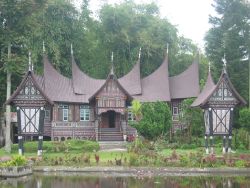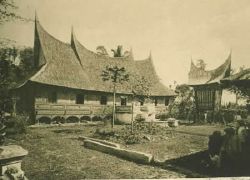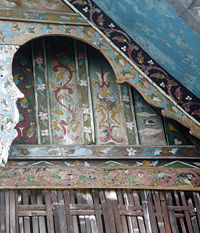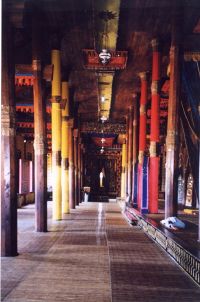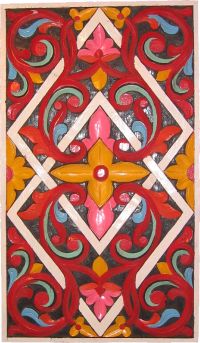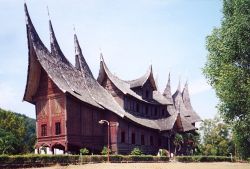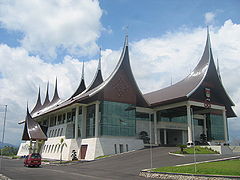Rumah Gadang
Rumah gadang (Minangkabau language: "Big house") are the traditional homes (Indonesian: Rumah adat) of the Minangkabau (also known as Minang or Padang), an ethnic group indigenous to the highlands of West Sumatra, in Indonesia. The architecture, construction, internal and external decoration, and the functions of the house reflect the culture and values of the Minangkabau. A rumah gadang serves as a residence and as a hall for family meetings and ceremonial activities. The Minangkabau society is matrilineal, and the rumah gadang is owned by the women of the family who lives there‚ÄĒownership is passed from mother to daughter.
The houses have a dramatic curved roof structure with multi-tiered, upswept gables. Shuttered windows are built into walls incised with profuse painted floral carvings. Every aspect of the house has a symbolic significance related to Minangkabau adat (customary belief and law). The upward-curved finials (gonjong) on the peaks of the roof, said to represent buffalo horns, symbolize reaching to Heaven. The walls on the front and back elevations (dindiang tapi), traditionally made of plaited strips of bamboo, symbolize the strength and utility of the community which is formed when individual become part of the whole instead of standing alone. The arrangement of rooms in the house is seen as a reflection of a woman's life pattern, forming a journey from the central post to the public area (anjuang), then the bedrooms (biliak), and lastly to the kitchen.
Background
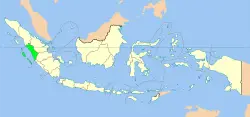
Sumatra is the sixth largest island in the world and since the time of Marco Polo has been referred to as the "island of gold." Including its tea, pepper and rubber plantations, and oil, tin and other minerals, it has more resources than any other island of Indonesia.[1] Lying on the equator, Sumatra has a monsoonal climate and although more rain falls between October and May, there is no extended rainless dry season. Despite large-scale deforestation, Sumatra still has millions of acres of unexploited rain forests which provide building materials. The great hardwood trees required for large scale construction are now, however, in strictly limited supply.[1]
Sumatra is home to one of the most diverse range of peoples in the South East Asian archipelago and this diversity is reflected in a range of often dramatic traditional homes known as rumah adat. The most common forms of housing have traditionally been raised on piles, built of wood and locally gathered materials, with steeply pitched roofs. In addition to the Minangkabau's rumah gadang, the Batak of the Lake Toba region build the boat-shaped jabu with dominating carved gables and dramatic over-sized roofs, and the people of Nias build the fortified omo sebua houses on massive ironwood pillars with towering roof structures.
The Minangkabau are indigenous to the highlands of central Sumatra. Their culture is matrilineal, with property and land being passed down from mother to daughter, while religious and political affairs are the province of men. The Minangkabau are strongly Islamic, but also follow their own ethnic traditions, or adat (customary law). Minangkabau adat was derived from animistic and Hindu beliefs before the arrival of Islam, and remnants of animistic beliefs still exist even among some practicing Muslims. Women are customarily the property owners; husbands are only tolerated in the house at certain times and under special conditions, and must return to their sisters' house to sleep. Complementing this practice is the custom of merantau whereby many of the men travel far from home for work, returning only periodically to their village of origin. Money earned on these trips is remitted for the building of contemporary rumah adapt.[1]
The term rumah gadang usually refers to larger communal homes, but smaller single residences share many of its architectural elements.
It is not clear when the rumah gadang was first built; it is said to have originated in Pariangan, Batusangkar, the site of an early Minangkabau village. Pagaruyung Palace (in Batusangkar) dates to the Pagaruyung kingdom in the thirteenth century. It was burnt to the ground in 1804, was reconstructed and burned again several times. The current structure is a replica built in 2007.[2]
Form
A communal rumah gadang is a long house, rectangular in plan, with multiple gables and upsweeping ridges, forming buffalo horn-like ends. They normally have three-tiered projections, each with varying floor levels. They are broad and set on wooden piles that can reach as high as 3 meters (10 feet) off the ground; sometimes with a verandah running along the front face of the house which is used as a reception and dining area, and as a sleeping place for guests. Unlike the Toba Batak homes, where the roof essentially creates the living space, the Minangkabau roof rests on conventional walls. Cooking and storage areas are often in separate buildings.
The house is largely constructed of wood; an exception being the being the rear longitudinal wall which is a plain lattice woven in a chequered pattern from split bamboo. The roof is of a truss and cross-beam construction, and is typically covered with thatch from the fiber of the sugar palm (ijuk), which is the toughest thatch material available and is said to last a hundred years.[1] The thatch is laid in bundles which can be easily fitted to the curved, multi-gabled roof. Contemporary homes are more frequently using corrugated iron in place of thatch.
Roof finials are formed at the peaks from thatch bound by decorative metal bindings and drawn into points said to resemble buffalo horns‚ÄĒan allusion to a legend concerning a battle between two water buffaloes from which the "Minangkabau" name is thought to have been derived. The roof peaks themselves are built up out of many small battens and rafters.
The women who share the house have sleeping quarters in alcoves, traditionally odd in number, set in a row against the rear wall, and curtained off by the vast interior space of the main living area. Traditionally, large communal rumah gadang are surrounded by smaller homes built for married sisters and daughters of the parent family. It is the responsibility of the women's maternal uncle to ensure that each marriageable woman in the family has a room of her own, and this is accomplished either by building a new house or, more commonly, by adding annexes to the original one. It is said that the number of married daughters in a home can be known by counting its horn-like extensions; as they are not always added symmetrically, rumah gadang can sometimes look unbalanced. Adolescent boys traditionally live in the village surau, a small mosque.
Architectural elements
Each element of a rumah gadang has a symbolic meaning, which is referred to in adat speech and aphorisms.
The elements of a rumah gadang include:
- Gonjong hornlike roof structure
- Singkok triangular wall under the ends of gonjong
- Pereng, shelf under the singkok
- Anjuang raised floor at the end of one style of rumah gadang
- Dindiang ari, the walls on the side elevations
- Dindiang tapi, the walls on the front and back elevations
- Papan banyak, front facade
- Papan sakapiang, a shelf or middle band on the periphery of the house
- Salangko, wall enclosing space under a house that has been built on stilts
The upward-curved finials, or gonjong, on the peaks of the roof symbolize reaching to Heaven. The dindiang tapi, traditionally made of plaited strips of bamboo, symbolizes the strength and utility of the community which is formed when individual Minangkabau become part of the larger whole instead of standing alone.
The pillars of the ideal rumah gadang are arranged in five rows which run the length of the house. These rows divide the interior into four long spaces called lanjar. The lanjar at the rear of the house is divided into bedrooms (ruang). According to adat, a rumah gadang must have at least five ruang, and the ideal number is nine. The other lanjar are used as a common area, called the labuah gajah (elephant road), for living and ceremonial events.
Large communal homes are entered through a doorway in the center of the structure which is usually surrounded by a perpendicular porch with a triangular gable and upsweeping peaked ridge end. The variation with no entry porch is named bapaserek or surambi papek ("without veranda"). Immediately after the entrance comes a middle area (rumah tongah), where there is normally a central post; adjoining this the anjuang, and the bedrooms (biliak). Opposite the anjuang is the kitchen, and in front of that a large space (pangkalan) where visitors are received. Though the rumah gadang is a meeting place for all, it is essentially a women's domain. The arrangement of rooms in the house is seen as a reflection of a woman's life pattern, forming a journey from the central post to the anjuang, then the biliak, and lastly to the kitchen.[3]
A number of rice barns (rangkiang) typically accompany a rumah gadang, with each having a different name and function. The rangkiang sitinjau lauik contains rice for guests and visitors and for the family on special occasions such as adat ceremonies. The rangkiang sitangka lapa contains rice for donation to poor villagers and for times of famine in the village. The rangkiang sibayau-bayau contains rice for the daily needs of the family.
Ornamentation
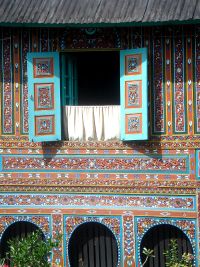
The Minangkabau traditionally embellish the wooden walls, pillars, and ceilings of the rumah gadang with bas-relief carved wooden motifs that reflect and symbolize their adat. The motifs consists of profuse floral designs based on a simple underlying geometric structure, and are similar to those of the Minangkabau woven songket textiles, with colors thought to have been derived from Chinese brocades.[1] Traditionally, the motifs do not show animals or humans in a realistic form, although some may represent animals, human beings, or their activities or behavior. The motifs are based on the Minangkabau concept of aesthetics, part of their view of their world (Alam Minangkabau), in which aesthetic expression is always based upon the natural environment. A well-known adat aphorism says, ‚Äúnature is our teacher.‚ÄĚ
Ninety-four motifs have been observed on rumah gadang. Thirty-seven of them refer to flora, such as kaluak paku ('fern tendrils'), saluak laka ("interwoven rattan"), pucuak rabuang ("bamboo shoots"), areca-nut palms, and lumuik hanyuik ('washed-away moss'). Twenty-eight motifs refer to fauna, such as tupai tatagun ("startled squirrel"), itiak pulang patang ("ducks going home in the afternoon") which symbolizes co-operation and homecoming wanderers, and kumbang janti (golden bumblebee). The remaining twenty-nine motifs refer to humans and sometimes to their activities or behavior, such as rajo tigo (three kings of the realm), kambang manih (sweet flower, used to describe an amiable girl) and jalo takambang (casting a net).[1]
Variations
The rumah gadang is built in one of two basic designs: koto piliang and bodi caniago, reflecting two variations of Minangkabau social structure. The koto piliang design reflects an aristocratic and hierarchical social structure, with the house containing anjuang (raised floors) at each end to permit elevated seating of clan leaders during ceremonial events. The bodi caniago design reflects a democratic social structure, with flat floors on one level.
The larger and more opulent houses have higher walls and multiple roofs, often with five elements inserted into each other, and supported by large wooden columns. Variations on the number of columns are known as gajah maharam ("elephant kneeling"), which may have forty columns resulting in a shorter and stouter form, and the rajo babandiang ("design of grandeur") with fifty pillars and a more slender form. An additional six columns are required at each end for the anjuang of the koto piliang variation.
A Minangkabau traditional council hall, known as a balai adapt, appears similar to a rumah gadang. This type of building is used by clan leaders as a meeting place, and it is not enclosed by walls, except for the anjuang of the Koto Piliang model. The Pagaruyung Palace, the traditional seat of seat of Minangkabau kings, is built in the traditional Minangkabau rumah gadang architectural style, but is unusual because it has three levels. In West Sumatra some modern government and commercial buildings, and domestic houses (rumah gedung), have adopted elements of the rumah gadang style.
There has been a sizable Minangkabau settlement in Negeri Sembilan (now in Malaysia) since the seventeenth century; the chief of the Minangkabau is still regarded as the ruler there. The Negeri Sembilan Minangkabau, however, have adopted Malay-style roof construction, with a continuous ridge piece thatched with lengths of palm-leaf attached to battens. Although this style does not have the characteristic curved roof and has blunter eaves, it is still considered dignified and beautiful. Islamic influence has also led to variations such as modifications to the interior layout, as women are more restricted to the rear of the house than in the case of the matrilineal Sumatran Minangkabau.[1]
Construction
The construction of a house is subject to specific regulations, laid down by the ancestors and formalized in adat, that must be observed if the house is to become a beautiful and pleasant dwelling. The construction of the house symbolizes the division of the macrocosm into three regions: the upper world, the seat of deities, and ancestors. The construction and maintenance of a rumah gadang is the responsibility of ninik mamak, the elder male blood-relatives of the matrilineal descent group that owns and builds it.
A rumah gadang is constructed without the use of nails. No foundation is sunk into the ground; like many buildings in Southeast Asia it is built on stilts erected on a layer of stones placed over the earth. During an earthquake, the structure moves slowly and flexibly. However, being constructed largely of wood, it is most vulnerable to fire.
Use
Rumah gadang were traditionally inhabited by a single family group of three or four generations descended from one ancestor. Each of the Minangkabau identifies completely with his or her own rumah gadang.[3] Rumah gadang, in addition to serving as family residences, were used to hold family or tribal councils, weddings and adat ceremonies, and meetings to choose a successor when a tribal leader died.
Today rumah gadang are rarely occupied as people prefer to live in modern houses. Rumah gadang can still be found in West Sumatra, and efforts are being made to preserve the old buildings.[3]
Notes
- ‚ÜĎ 1.0 1.1 1.2 1.3 1.4 1.5 1.6 1.7 Barry Dawson and John Gillow, The Traditional Architecture of Indonesia (London: Thames and Hudson, 1994, ISBN 050034132X).
- ‚ÜĎ Pagaruyung Palace Alluring World. Retrieved September 27, 2019.
- ‚ÜĎ 3.0 3.1 3.2 Artasia.com, Traditional Houses Retrieved September 27, 2019.
ReferencesISBN links support NWE through referral fees
- Dawson, Barry, and John Gillow. The Traditional Architecture of Indonesia. London: Thames and Hudson Ltd. 1994. ISBN 050034132X.
- Ng, Cecilia. ‚ÄúRaising the House Post and Feeding the Husband Givers: The Spatial Categories of Social Reproduction Among the Minangkabau.‚ÄĚ Inside Austronesian Houses: Perspectives on Domestic Designs for Living. Retrieved September 27, 2019.
- Summerfield, Anne, and John Summerfield. Walk in Splendor: Ceremonial Dress and the Minangkabau. UCLA, 1999. ISBN 0930741730.
- Vellinga, Marcel. A family affair: the construction of vernacular Minangkabau houses Indonesia and the Malay World. 32(92) (2004): 100-118. Retrieved September 27, 2019.
- Vellinga, Marcel. Constituting Unity And Difference: Vernacular Architecture In A Minangkabau Village. Koninklijk Instituut Voor de Tropen, 2005. ISBN 9067182303.
External Links
All links retrieved December 22, 2022.
- Artasia.com Traditional Houses
Credits
New World Encyclopedia writers and editors rewrote and completed the Wikipedia article in accordance with New World Encyclopedia standards. This article abides by terms of the Creative Commons CC-by-sa 3.0 License (CC-by-sa), which may be used and disseminated with proper attribution. Credit is due under the terms of this license that can reference both the New World Encyclopedia contributors and the selfless volunteer contributors of the Wikimedia Foundation. To cite this article click here for a list of acceptable citing formats.The history of earlier contributions by wikipedians is accessible to researchers here:
The history of this article since it was imported to New World Encyclopedia:
Note: Some restrictions may apply to use of individual images which are separately licensed.
